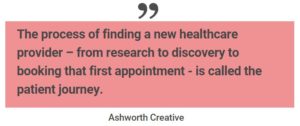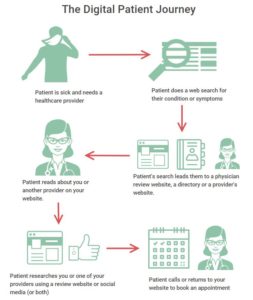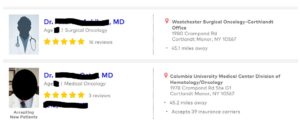Image Source: Unsplash
A 2017 study by reputation management company Yext revealed that more than half of patients find information about a specific provider outside of that provider’s website.
In this post, we’ll discuss ways that you can make your practice more visible on external websites such as physician directories and review sites.
We’ll also review the importance of content marketing in the context of building awareness about your practice beyond your website and how this can help attract new patients (and retain existing ones)
An overview of how patients find doctors online
The process of finding a new healthcare provider – from research to discovery to booking that first appointment – is called the patient journey. This journey has increasingly become digitized thanks to the Internet and the ubiquity of smartphones as a tool to research just about everything in our lives.
The patient journey is a type of buying cycle, but it differs from buying cycles in other industries. Patients are not consumers, though it may be tempting to refer to them this way. People have a very different mindset when looking for a new health care provider or researching a health service than they do when shopping for shoes or art supplies.
There are certain obstacles such as health insurance and proximity to care that factor into a person’s search for a new provider. We can’t order an eye exam from Amazon – at least not yet – so we still must go through the process of researching and discovering local providers that take our insurance.
Here is an overview of the typical digital patient journey to find a new healthcare provider:
- The web search (awareness/research) – over half of patients in the Yext study chose healthcare providers from information they received outside of the provider’s website. They start at Google or another search engine and healthcare directories and review sites.
- Your website (consideration) – The search engine or directory/review website leads the prospective patient to your website, where they learn about your practice, services, and providers.
- Your reputation (schedule appointment) – After visiting your website and selecting a potential provider, the prospective patient researches that provider on a third-party physician directory or review website such as Healthgrades
The quest to find a new provider is rarely straightforward. In addition to the above steps, there are other online sources that prospective new patients will use to find you. These include articles about symptoms and conditions and recommendations from contacts on social media. The flow from awareness to “new patient” isn’t a straight line, but looks something like this:
What are physician review websites?
Since physician review websites play a big role in how patients find doctors online, it’s important for providers to understand what they are.
Websites like Healthgrades and RateMDs, allow consumers to search for providers in a variety of ways including name, specialty, location, and more. Healthgrades enables users to narrow down their provider search by specialty, condition, or procedure.
Image Source: Healthgrades
Claiming your listing on popular physician review sites gives you control over how your profile appears to potential patients.
Image Source: Healthgrades
In the above example, the two providers listed for the category “breast cancer” are located within .1 miles of each other, but the first physician hasn’t claimed his profile. There’s no profile photo or insurance information. There’s also no phone number as is the case with the second listing. The claimed listing also states that the physician is accepting new patients.
Claiming your profile is free on Healthgrades, though there are premium profiles available (for a fee).
Once you claim your profile, you can make sure it’s complete with the most up-to-date information about your practice.
Image Source: Healthgrades
Another reason to claim and update your profile: the most popular physician review websites rank well on Google which is a key reason why prospective patients visit them before going to your practice website.
The overwhelming majority of patients find your office location using third-party websites, with only 26% of respondents in the Yext study reporting they learned the address of their healthcare provider from the provider’s website (52% said they got the address from a search engine or mapping app and 13% got the address from directory or review websites).
But while third-party websites are an important part of the digital patient journey, your website is also a crucial stop along the way.
Your website is your digital office
Prospective patients may visit your website multiple times before committing to an appointment. That’s why it’s important to keep your site up to date and focused on providing the most relevant information.
A comprehensive healthcare website should include information about your practice (address, insurance information, etc), your specialties, the conditions that you treat and include information about each and every provider that’s part of your group.
This last point is particularly important since patients search for physicians before they search for a facility (76% vs. 30% in the Yext study).
Your website should act as the online hub for everything related to your practice. It provides an opportunity for you to include valuable content about symptoms and conditions that patients are searching for – content that can be presented in a variety of ways (graphics, videos, checklists, etc.). Deep content about a specific topic is more likely to show up on a Google search than shallow, superficial information.
Conclusion
The online patient journey is a reflection of the changing ways people are managing all aspects of their lives in the digital age.
Understanding the arc of this journey – from awareness to consideration to the first booked appointment – can help you reach potential patients at every stage of their research process.






